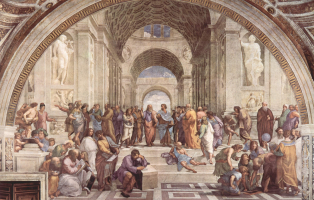Top 10 Definition Essay Examples about Business & Finance
Embark on a journey through the core concepts of Business & Finance with our collection of definition essay examples. From Entrepreneurship to Corporate ... read more...Responsibility, these brief essays simplify complex ideas for a clearer understanding of the financial world.
-
Essay topic: Unveiling the World of Business for High School Students.
Answer:
In the vibrant tapestry of our communities, businesses play a vital role in shaping the way we live and interact. Business, simply put, is the activity of providing goods or services in exchange for money. Let's explore this concept in a simple yet meaningful way, understanding its impact on our daily lives.
Business is not a mysterious endeavor conducted in lofty towers; it's the shops, restaurants, and services we encounter every day. From the local grocery store where we buy our snacks to the small cafes offering cozy spaces to chat with friends, businesses are woven into the fabric of our neighborhoods. They provide the things we need and the experiences we enjoy.
Business is not about complicated plans or secret strategies; it's the exchange of goods or services for money. When you buy a book, get a haircut, or enjoy a meal at a restaurant, you are engaging in business transactions. It's the simple act of giving and receiving, creating a cycle that keeps our communities vibrant and connected.
In the bustling world of high school, business is the entrepreneurial spirit that drives students to explore their ideas and turn them into reality. It's the bake sales, the creative projects, and the clubs organizing events - activities that involve planning, execution, and the joy of achievement. Even during challenging times, the spirit of business persists, reminding us that every effort, big or small, contributes to the thriving tapestry of our community.
In conclusion, business is not a distant and complex concept but a continuous part of our high school experience, waiting to be discovered in the tapestry of our daily lives. It's the local shops, the student-led initiatives, and the exchanges that enrich our understanding of the world. As high school students navigating the complexities of community life, recognizing and celebrating the meaning of business in the ordinary moments can add a touch of entrepreneurial spirit to our shared journey.

Photo by Pixabay via pexels 
Photo by Pixabay via pexels -
Essay topic: The Meaning of Money for High School Students.
Answer:
In the intricate dance of daily life, money plays a crucial role, shaping the way we navigate the world around us. Money, in its simplest form, is a tool used for buying and selling goods and services. Let's explore this concept in a straightforward yet meaningful way, understanding its significance in our everyday experiences.
Money is not a complex mystery hidden away in bank vaults; it's the coins and bills we use to purchase items and make exchanges. From buying a snack at the cafeteria to getting a ticket for a school event, money is woven into the fabric of our daily transactions. It's the means by which we acquire what we need and participate in the various activities that make life enjoyable.
Money is not about complicated finance strategies or secret codes; it's a representation of value. When you exchange money for a new book, a slice of pizza, or even a movie ticket, you're essentially swapping it for something you find valuable. It's a simple way to express the worth of different goods and services in our society.
In the bustling world of high school, money is the allowance we earn or receive, teaching us early lessons in budgeting and decision-making. It's the currency that circulates within student-led initiatives, whether it's fundraising for a cause or organizing events. Even during challenging times, the concept of money persists, reminding us that every coin and bill carries a story of value and exchange.
In conclusion, money is not a distant and complex concept but a continuous part of our high school experience, waiting to be discovered in the tapestry of our daily lives. It's the pocket change, the budgeting decisions, and the exchanges that enrich our understanding of the world. As high school students navigating the complexities of financial literacy, recognizing and celebrating the meaning of money in the ordinary moments can add a touch of practical wisdom to our shared journey.

Photo by Pixabay via pexels 
Photo by Pixabay via pexels -
Essay topic: The Art of Buying and Selling for High School Students.
Answer:
In the vibrant rhythm of our daily lives, buying and selling emerge as essential beats, shaping the way we obtain what we need and share with others. Buying and selling, at its core, is the simple act of exchanging goods or services for money. Let's delve into this concept in a clear yet meaningful way, unraveling its significance in our everyday experiences.
Buying and selling are not mysterious rituals conducted in distant markets; they're the familiar exchanges happening all around us. From purchasing a favorite snack at the school store to selling handmade crafts at a local fair, buying and selling are threads woven into the fabric of our community. It's the way we acquire things we desire and contribute to the flow of goods and services.
Buying and selling are not about complicated negotiations or secret codes; they're the straightforward transactions that occur every day. When you buy a pencil for school or sell a piece of artwork to a friend, you're engaging in this timeless exchange. It's the natural give-and-take that allows us to share what we have and obtain what we need.
In the bustling world of high school, buying and selling are the entrepreneurial sparks that ignite student-led initiatives. From organizing bake sales to trading items at flea markets, it's the spirit of commerce that encourages creativity, planning, and collaboration. Even during challenging times, the concept of buying and selling persists, reminding us that every transaction, big or small, is a building block in the vibrant tapestry of our community.
In conclusion, buying and selling are not distant and complex concepts but continuous parts of our high school experience, waiting to be discovered in the tapestry of our daily lives. It's the simple exchanges, the entrepreneurial endeavors, and the transactions that enrich our understanding of the world. As high school students navigating the complexities of community life, recognizing and celebrating the meaning of buying and selling in the ordinary moments can add a touch of practical wisdom to our shared journey.

Photo by Pixabay via pexels 
Photo by Pixabay via pexels -
Essay topic: Understanding the Role of Customers for High School Students.
Answer:
In the mosaic of daily interactions, customers play a central role, influencing the way businesses operate and shaping our experiences as consumers. Customers, in simple terms, are individuals who buy goods or services. Let's explore this concept in a straightforward yet meaningful way, understanding the significance of customers in our daily lives.
Customers are not distant figures in a business equation; they're the people like you and me who purchase items or services. From buying a school uniform at the store to grabbing a snack at the cafeteria, customers are integral to the transactions that occur around us. They are the individuals contributing to the lifeblood of businesses, fueling the exchange of goods and services.
Customers are not mysterious entities with specific requirements; they're individuals making choices based on their needs and preferences. When you decide to buy a notebook for class or enjoy a meal at a local restaurant, you become a customer. It's a straightforward role that allows individuals to access the things they require and desire.
In the bustling world of high school, customers are the students who seek value in the products and services available within the community. From attending school events to participating in fundraisers, students become both contributors and beneficiaries of the customer relationship. Even during challenging times, the concept of customers persists, reminding us that each transaction is a chance to meet needs and build connections.
In conclusion, customers are not abstract figures but an integral part of our high school experience, waiting to be recognized in the tapestry of our daily lives. They are the faces behind transactions, the decision-makers, and the individuals who fuel the heartbeat of businesses. As high school students navigating the complexities of community life, recognizing and celebrating the role of customers in the ordinary moments can add a touch of awareness and appreciation to our shared journey.

Photo by Quintin Gellar via pexels 
Photo by Andrea Piacquadio via pexels -
Essay topic: Unveiling the Concept of Profit for High School Students.
Answer:
In the lively dance of commerce and transactions, profit stands as a key player, influencing the way businesses operate and thrive. Profit, in simple terms, is the money a business earns after subtracting its expenses. Let's explore this concept in a straightforward yet meaningful way, understanding the significance of profit in our everyday experiences.
Profit is not a mysterious concept hidden in financial jargon; it's the positive outcome when a business earns more money than it spends. From the local bakery selling delicious treats to the school store offering supplies, profit is woven into the fabric of these transactions. It represents the financial reward that businesses receive for their efforts.
Profit is not about complex calculations or secret strategies; it's a straightforward measure of success. When a business earns more money than it spends on costs like ingredients, rent, and salaries, it makes a profit. It's a simple way to gauge whether a business is financially thriving and sustainable.
In the bustling world of high school, profit is the entrepreneurial spark that ignites student-led initiatives. From organizing fundraisers to selling handmade crafts, students learn firsthand about the concept of profit. Even during challenging times, the pursuit of profit persists, reminding us that each effort contributes to financial success and sustainability.
In conclusion, profit is not a distant and complex concept but a continuous part of our high school experience, waiting to be discovered in the tapestry of our daily lives. It's the financial reward, the measure of success, and the motivation for businesses, whether big or small. As high school students navigating the complexities of community life, recognizing and celebrating the meaning of profit in the ordinary moments can add a touch of financial awareness to our shared journey.

Photo by Nataliya Vaitkevich via pexels 
Photo by Pixabay via pexels -
Essay topic: Exploring Goods and Services for High School Students.
Answer:
In the vibrant mosaic of our daily lives, goods and services emerge as essential elements, shaping the way we obtain what we need and experience the world around us. Goods and services, in simple terms, are the things we buy and the tasks others do for us. Let's explore this concept in a straightforward yet meaningful way, understanding its significance in our everyday experiences.
Goods are not mysterious items on a store shelf; they are the tangible things we can touch, own, and use. From the school supplies we purchase for class to the snacks we enjoy during breaks, goods are integral to our daily transactions. They are the physical items that add value and functionality to our lives.
Services, on the other hand, are not elusive tasks in the background; they are the actions others perform to help us. From a hairdresser styling our hair to a school bus driver taking us to and from school, services are the tasks that make our lives easier and more enjoyable. They are the intangible contributions that enhance our daily experiences.
In the bustling world of high school, goods and services are the heartbeat of student-led initiatives. From organizing events to offering tutoring sessions, students provide both goods and services to their peers. Even during challenging times, the concept of goods and services persists, reminding us that every exchange, whether trading a book or offering help, contributes to the vibrant tapestry of our community.
In conclusion, goods and services are not distant and complex concepts but continuous parts of our high school experience, waiting to be discovered in the tapestry of our daily lives. They are the items we exchange, the tasks that make life easier, and the ways we contribute to the well-being of our community. As high school students navigating the complexities of community life, recognizing and celebrating the meaning of goods and services in the ordinary moments can add a touch of practical wisdom to our shared journey.

Photo by Tima Miroshnichenko via pexels 
Photo by Tima Miroshnichenko via pexels -
Essay topic: Discovering the Art of Buying on Sale for High School Students.
Answer:
In the lively rhythm of our high school experiences, the concept of buying on sale adds a touch of savvy decision-making to our everyday transactions. Buying on sale, in simple terms, is the act of purchasing items at a reduced price. Let's explore this concept in a straightforward yet meaningful way, understanding its significance in our daily lives.
Buying on sale is not a complex strategy reserved for shopping experts; it's a smart choice that allows us to get the things we want at a lower cost. From school supplies to trendy clothing, buying on sale is a thread woven into the fabric of our student lives. It's the opportunity to stretch our budget and make our money go a little further.
Buying on sale is not about complicated calculations or hidden discounts; it's the chance to enjoy discounts and save money. When a store offers a sale, it means the prices are temporarily reduced, giving us a chance to buy our favorite items at a more affordable price. It's a simple way to be a smart and budget-conscious shopper.
In the bustling world of high school, buying on sale is the financial wisdom that students embrace. From seasonal sales to special promotions, students learn to navigate the world of discounts, making their money work for them. Even during challenging times, the concept of buying on sale persists, reminding us that every opportunity to save is a step toward financial independence.
In conclusion, buying on sale is not a distant and complex concept but a continuous part of our high school experience, waiting to be discovered in the tapestry of our daily lives. It's the budget-friendly choice, the opportunity to save, and the financial wisdom that adds a practical touch to our student journey. As high school students navigating the complexities of budgeting, recognizing and celebrating the art of buying on sale in the ordinary moments can add a touch of financial empowerment to our shared journey.

Photo by Max Fischer via pexels 
Photo by Max Fischer via pexels -
Essay topic: Decoding the World of Advertising for High School Students.
Answer:
In the vibrant tapestry of our high school experiences, advertising emerges as a powerful communicator, influencing the way we discover products and engage with the world around us. Advertising, in simple terms, is the act of promoting goods or services to attract the attention of potential customers. Let's explore this concept in a straightforward yet meaningful way, understanding its significance in our daily lives.
Advertising is not a mysterious art reserved for professionals; it's a creative tool used by businesses to showcase what they offer. From posters in the hallways promoting school events to commercials on TV, advertising is woven into the fabric of our daily environment. It's the way we learn about new products, events, and opportunities.
Advertising is not about complex messages or hidden persuasions; it's a straightforward way for businesses to share information. When you see a flyer announcing a school club meeting or a social media post about an upcoming concert, you are encountering advertising. It's the means by which information is communicated to a broader audience, helping people stay informed and engaged.
In the bustling world of high school, advertising is the creative spark that fuels student-led initiatives. From promoting fundraisers for important causes to inviting peers to join clubs, students use advertising to spread the word and gather support. Even during challenging times, the concept of advertising persists, reminding us that effective communication is a valuable skill.
In conclusion, advertising is not a distant and complex concept but a continuous part of our high school experience, waiting to be discovered in the tapestry of our daily lives. It's the informative posters, the announcements, and the creative promotions that enrich our understanding of the world. As high school students navigating the complexities of communication, recognizing and celebrating the meaning of advertising in the ordinary moments can add a touch of awareness and creativity to our shared journey.

Photo by Jose Antonio Gallego Vázquez via pexels 
Photo by Jose Francisco Fernandez Saura via pexels -
Essay topic: Navigating the Dance of Supply and Demand for High School Students.
Answer:
In the vibrant rhythm of our high school experiences, the concept of supply and demand plays a pivotal role, influencing the availability and pricing of goods and services. Supply and demand, in simple terms, are the forces that shape how much of something is available and how much people want it. Let's explore this concept in a straightforward yet meaningful way, understanding its significance in our daily lives.
Supply and demand are not mysterious economic forces; they're the simple factors that determine what is offered and sought after in our community. From the availability of school supplies in the bookstore to the popularity of snacks in the cafeteria, supply and demand are threads woven into the fabric of our student lives. They are the elements that influence the choices we make as consumers.
Supply and demand are not about complex calculations or hidden formulas; they're the natural ebb and flow of availability and desire. When something is in high demand, like tickets to a school event, it becomes more sought after, and its availability may decrease. On the other hand, when something is readily available but less in demand, its price may decrease. It's a simple dance that shapes our daily transactions.
In the bustling world of high school, supply and demand are the economic forces that students encounter daily. From limited edition merchandise selling out quickly to the popularity of certain cafeteria menu items, students witness these principles in action. Even during challenging times, the concept of supply and demand persists, reminding us that our choices influence what's available and at what price.
In conclusion, supply and demand are not distant and complex concepts but continuous parts of our high school experience, waiting to be discovered in the tapestry of our daily lives. They are the availability of goods, the choices we make, and the economic dance that adds a practical touch to our student journey. As high school students navigating the complexities of choices, recognizing and celebrating the dynamics of supply and demand in the ordinary moments can add a touch of economic awareness to our shared journey.

Photo by Antoni Shkraba via pexels 
Photo by Antoni Shkraba via pexels -
Essay topic: Unveiling Economic Growth for High School Students.
Answer:
In the vibrant mosaic of our high school experiences, the concept of economic growth emerges as a powerful force, influencing the prosperity and opportunities within our community. Economic growth, in simple terms, is the expansion of the economy, leading to increased production, income, and overall well-being. Let's explore this concept in a straightforward yet meaningful way, understanding its significance in our daily lives.
Economic growth is not a distant and abstract idea; it's the steady improvement in the financial health of our community. From new businesses opening in the neighborhood to increased opportunities for part-time jobs, economic growth is woven into the fabric of our student lives. It represents the positive evolution that contributes to the overall well-being of our community.
Economic growth is not about complex numbers or hidden formulas, it's the visible signs of progress and improvement. When the local economy grows, it means there are more opportunities for employment, more businesses thriving, and more resources available for community initiatives. It's a simple measure of the collective prosperity of our community.
In the bustling world of high school, economic growth is the backdrop against which students pursue their goals. From participating in school events to exploring potential careers, students benefit from the opportunities that arise in times of economic growth. Even during challenging times, the concept of economic growth persists, reminding us that every effort to enhance the community contributes to its overall development.
In conclusion, economic growth is not a distant and complex concept but a continuous part of our high school experience, waiting to be discovered in the tapestry of our daily lives. It's the opportunities that arise, the progress that unfolds, and the collective well-being that enriches our understanding of the world. As high school students navigating the complexities of community life, recognizing and celebrating the meaning of economic growth in the ordinary moments can add a touch of awareness and optimism to our shared journey.

Photo by Tima Miroshnichenko via pexels 
Photo by Tima Miroshnichenko via pexels































